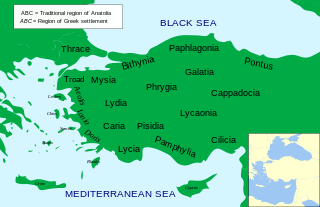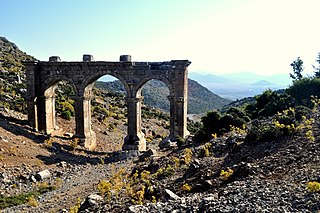Related Research Articles

Chalcedon was an ancient maritime town of Bithynia, in Asia Minor. It was located almost directly opposite Byzantium, south of Scutari and it is now a district of the city of Istanbul named Kadıköy. The name Chalcedon is a variant of Calchedon, found on all the coins of the town as well as in manuscripts of Herodotus's Histories, Xenophon's Hellenica, Arrian's Anabasis, and other works. Except for the Maiden's Tower, almost no above-ground vestiges of the ancient city survive in Kadıköy today; artifacts uncovered at Altıyol and other excavation sites are on display at the Istanbul Archaeological Museum.

Lycaonia was a large region in the interior of Asia Minor, north of the Taurus Mountains. It was bounded on the east by Cappadocia, on the north by Galatia, on the west by Phrygia and Pisidia, while to the south it extended to the chain of Mount Taurus, where it bordered on the country popularly called in earlier times Cilicia and in the Byzantine period Isauria; but its boundaries varied greatly at different times. The name is not found in Herodotus, but Lycaonia is mentioned by Xenophon as traversed by Cyrus the Younger on his march through Asia. That author describes Iconium as the last city of Phrygia; and in Acts 14:6 Paul, after leaving Iconium, crossed the frontier and came to Lystra in Lycaonia. Ptolemy, on the other hand, includes Lycaonia as a part of the province of Cappadocia, with which it was associated by the Romans for administrative purposes; but the two countries are clearly distinguished both by Strabo and Xenophon and by authorities generally.
Selymbria, or Selybria (Σηλυβρία), or Selybrie (Σηλυβρίη), was a town of ancient Thrace on the Propontis, 22 Roman miles east from Perinthus, and 44 Roman miles west from Constantinople, near the southern end of the wall built by Anastasius I Dicorus for the protection of his capital. Its site is located at Silivri in European Turkey.
Sozopolis in Pisidia, which had been called Apollonia (Ἀπολλωνία) and Apollonias (Ἀπολλωνίας) during Seleucid times, was a town in the former Roman province of Pisidia, and is not to be confused with the Thracian Sozopolis in Haemimonto in present-day Bulgaria. Its site may correspond to present-day Uluborlu in Isparta Province, Turkey.

Apamea Cibotus, Apamea ad Maeandrum, Apamea or Apameia was an ancient city in Anatolia founded in the 3rd century BC by Antiochus I Soter, who named it after his mother Apama. It was in Hellenistic Phrygia, but became part of the Roman province of Pisidia. It was near, but on lower ground than, Celaenae (Kelainai).

Ariassus or Ariassos was a town in Pisidia, Asia Minor built on a steep hillside about 50 kilometres inland from Attaleia.

Selge was an important city in ancient Pisidia and later in Pamphylia, on the southern slope of Mount Taurus, modern Antalya Province, Turkey, at the part where the river Eurymedon River forces its way through the mountains towards the south.
Polybotus or Polybotos was a city in the Roman province of Phrygia Salutaris. Its site is located 3 miles (4.8 km) southwest of Bolvadin in Asiatic Turkey.
Cotenna or Kotenna was a city in the Roman province of Pamphylia I in Asia Minor. It corresponds to modern Gödene, near Konya, Turkey.

Francis Vyvyan Jago Arundell (1780–1846) was an English antiquary, Anglican clergyman and oriental traveller.

Setae or Setai, or Settae or Settai (Σέτται), or Saettae or Saittai or Saittae (Σαίτται) was a town of ancient Lydia, located at Sidas Kaleh in Modern Turkey. The ruins of that town consist of a stadium, tombs and ruins of several temples. The town is not mentioned by any of the earlier writers, but appears in Ptolemy and Hierocles.

Tabala, was a Roman and Byzantine town and a Bishopric in ancient Lydia. Tabala was on the Hermus River, and minted its own coins. It was probably mentioned by Hierocles under the name of Gabala, which is perhaps only miswritten for Tabala. It is even possible that it may be the town of Tabae or Tabai (Τάβαι), which Stephanus of Byzantium assigns to Lydia.
Peltae (Peltæ) or Peltai was a city and bishopric of ancient Phrygia in Asia Minor, which remains a Catholic titular see.
Baris, called Baris in Hellesponto to distinguish it from other places called Baris, was an ancient city and bishopric in Asia Minor, which remains a Catholic titular see.
Zarela, also known as Durzela, Zorzila, Dyrzela, and Zorzela, was a city and bishopric in ancient Pisidia, which remains a Latin Catholic titular see. It site is unlocated.
Metropolis was an ancient town in the southern part of Phrygia, belonging to the conventus of Apamea. That this town is different from the more northerly town of the same name in northern Phrygia, is quite evident, even without knowing that Stephanus of Byzantium mentions two towns named Metropolis in Phrygia, and that Hierocles. and the Notitiae speak of a town of this name in two different provinces of Phrygia. In Roman times, it was assigned to the province of Pisidia, where it became a bishopric. No longer a residential see, it remains, under the name Metropolis in Pisidia, a titular see of the Roman Catholic Church.
Armene was an ancient Greek city on the Black Sea coast of ancient Paphlagonia. Xenophon in his Anabasis writes that the Ten Thousand on their return anchored their ships here, and stayed five days. The place belonged to the Sinopians. It was 50 stadia west of Sinope, and had a port. A small river, named Ochosbanes by Marcian of Heraclea, and named also Ochthomanes in the Anonymous Periplus, and Ocheraenus in the Periplus of Pseudo-Scylax, falls into the harbour.
Salmydessus or Salmydessos, also Halmydessus or Halmydissos (Ἁλμυδισσός), was a coast-town of ancient Thrace, on the Euxine, about 97 kilometres (60 mi) northwest of the entrance of the Bosporus. The eastern offshoots of the Haemus here come very close to the shore, which they divide from the valley of the Hebrus. The people of Salmydessus were thus cut off from communication with the less barbarous portions of Thrace, and became notorious for their savage and inhuman character, which harmonised well with that of their country, the coast of which was extremely dangerous. Aeschylus, who incorrectly places the town in Asia Minor, describes Salmydessus as "the rugged jaw of the sea, hostile to sailors, step-mother of ships;" and Xenophon informs us, that in his time its people carried on the business of wreckers in a very systematic manner, the coast being marked out into portions by means of posts erected along it, and those to whom each portion was assigned having the exclusive right to plunder all vessels and persons cast upon it. This plan, he says, was adopted to prevent the bloodshed which had frequently been occasioned among themselves by their previous practice of indiscriminate plunder. Strabo describes this portion of the coast of the Euxine as "desert, rocky, destitute of harbours, and completely exposed to the north winds;" while Xenophon characterises the sea adjoining it as "full of shoals." The earlier writers appear to speak of Salmydessus as a district only, but in later authors, as Apollodorus, Pliny the Elder, and Pomponius Mela, it is mentioned as a town.
Amblada was a town of ancient Lycaonia or of Pisidia, inhabited in Hellenistic, Roman, and Byzantine times. It was the seat of a bishop; no longer a residential see, it remains a titular see of the Roman Catholic Church. Strabo places it in Pisidia; the bishopric was suffragan to the metropolitan of Lycaonia. The coin minted copper coins during the period of the Antonines and their successors, with the epigraph Ἀμβλαδέων.
Dioclea or Dioklea, Dioclia or Dioklia, Diocleia or Diokleia, was a town of ancient Phrygia, inhabited during Roman and Byzantine times.
References
- ↑ John Anthony Cramer, A Geographical and Historical Description of Asia Minor, With a Map, Volume 2 (At the University Press, 1832), p. 314.
- ↑ Xenophon. Anabasis . Vol. 1.2.13.
- ↑ Strabo. Geographica . Vol. 14. Page numbers refer to those of Isaac Casaubon 's edition.
- ↑ Charles Anthon, A Classical Dictionary: Containing ... Proper Names Mentioned in Ancient Authors (Harper & Bros., 1841) p 768.
- ↑ Richard Talbert, ed. (2000). Barrington Atlas of the Greek and Roman World . Princeton University Press. p. 65, and directory notes accompanying.
- ↑ Lund University. Digital Atlas of the Roman Empire.
- ↑ Xenophon. Anabasis . Vol. 1.1.14.
- ↑ Travels in the Track of the Ten Thousand Greeks: being a geographical and descriptive account of the expedition of Cyrus, and of the retreat of the Ten Thousand Greeks, as related by Xenophon (J. W. Parker, 1844). page 33.
- ↑ Bernard Bachrach (April 2016). Jeffreys, Elizabeth; Gertwagen, Ruthy (eds.). "The Crusader March from Dorylaion to Herakleia". Shipping, Trade and Crusade in the Medieval Mediterranean Studies in Honour of John Pryor. Taylor & Francis: 243. Retrieved 25 September 2023.
- ↑ Francis-Vyiyan-Jago Arundell, Visit to the Seven Churches of Asia, with an Excursion Into Pisidia (John Rodwell, 1828) p203.
- ↑ Francis-Vyiyan-Jago Arundell, Visit to the Seven Churches of Asia, with an Excursion Into Pisidia (John Rodwell, 1828) p54.
- ↑ Richard Price, Michael Gaddis, The Acts of the Council of Chalcedon, Volume 1 (Liverpool University Press, 2005)p 84.
- ↑ Catholic Hierarchy
38°16′45″N31°54′50″E / 38.2791667°N 31.9138889°E